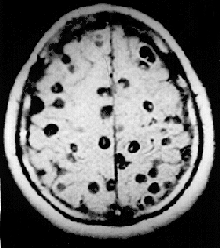Neurocysticercosis
Neurocysticercosis /ˈnjʊəroʊˌsɪstiˌsɜːrˈkoʊsɪs/ is a specific form of the infectious parasitic disease cysticercosis that is caused by the infection with Taenia solium, a tapeworm found in pigs. Neurocysticercosis occurs when cysts formed by the infection take hold within the brain, causing neurologic syndromes such as epileptic seizures. It is a common cause of seizures worldwide. It has been called a "hidden epidemic"[1] and "arguably the most common parasitic disease of the human nervous system".[2]

The infection of adult tapeworm often presents in different medical conditions depending on the body systems being affected. When humans are infected with Taenia solium, it causes an intestinal infection called taeniasis. Cysticerosis develops when multiple organs are affected, including the muscles, skin and eyes. Neurocysticerosis occurs when the larvae of Taenia solium invade the central nervous system. Common symptoms of neurocysticercosis include seizures, headaches, blindness, meningitis and dementia[3].
Pathophysiology
Neurocysticercosis most commonly involves the cerebral cortex followed by the cerebellum. The pituitary gland is very rarely involved in neurocysticercosis. The cysts may rarely coalesce and form a tree-like pattern which is known as racemose neurocysticercosis, which when involving the pituitary gland may result in multiple pituitary hormone deficiency.[4]
Diagnosis
Neurocysticerosis is diagnosed by computed tomography (CT) scan.[3] Diagnosis may be confirmed by detection of antibodies against cysticerci in CSF or serum[5] through ELISA or imunoblotting techniques.[6]
Treatment
Treatment of neurocysticerosis includes epileptic therapy and a long-course medication of praziquantel (PZQ) and/or albendazole.[3] Steroid therapy may be necessary to minimize the inflammatory reaction to dying cysticerci.[6] Surgical removal of brain cysts may be necessary,[6] e.g. in cases of large parenchymal cysts, intraventricular cysts or hydrocephalus.[7]
Albendazole can reduce the number of viable brain lesions and reduce seizures recurrence in those with non-viable brain lesions.[8]
For seizures further randomized controlled trials are needed to evaluate the efficacy of antiepileptic drugs (AED) for seizure prevention in patients with symptoms other than seizures and the duration of AED treatment in these cases.[9]
Epidemiology
The epidemiology of Taenia solium cysticercosis is solely associated with local cultural practices especially poor sanitation and is highly endemic in Sub-Saharan Africa, Latin America and Asia.[10][11] Infection by Taenia solium cysticercosis, the pork tapeworm larvae in human, spares no ethnic group.[12] Cysticercosis in the United States, which commonly presents in the form of neurocysticercosis, has been classified as a "neglected tropical disease",[13] which commonly affects the poor and homeless, particularly those without access or in the habit of inadequate hand-washing and in the habit of eating with their hands.
References
- Zimmer, Carl (15 May 2012). "Hidden Epidemic: Tapeworms Living Inside People's Brains". Discover Magazine.
- White, A. C. (1997). "Neurocysticercosis: A Major Cause of Neurological Disease Worldwide". Clinical Infectious Diseases. 24 (2): 101–13, quiz 114–5. doi:10.1093/clinids/24.2.101. PMID 9114131.
- "WHO | 10 facts about neurocysticercosis". WHO. Retrieved 2019-04-03.
- Dutta, Deep; Kumar, Mano; Ghosh, Sujoy; Mukhopadhyay, Satinath; Chowdhury, Subhankar (2013). "Pituitary hormone deficiency due to racemose neurocysticercosis". The Lancet Diabetes & Endocrinology. 1 (2): e13. doi:10.1016/S2213-8587(13)70026-3. PMID 24622323.
- Proaño-Narvaez, J. V.; Meza-Lucas, A.; Mata-Ruiz, O.; Garcia-Jerónimo, R. C.; Correa, D. (June 2002). "Laboratory Diagnosis of Human Neurocysticercosis: Double-Blind Comparison of Enzyme-Linked Immunosorbent Assay and Electroimmunotransfer Blot Assay". J Clin Microbiology. 40 (6): 2115–2118. doi:10.1128/JCM.40.6.2115-2118.2002. PMC 130799. PMID 12037074.
- Murray, P.; Rosenthal, K.; Pfaller, M. (2013). "Chapter 85 — Cestodes". Medical Microbiology (7th ed.). Philadelphia, PA, USA: Elsevier Saunders. p. 809. ISBN 978-0-323-08692-9.
- Rajshekhar (4 January 2010). "Surgical management of neurocysticercosis". International Journal of Surgery. 8 (2): 100–104. doi:10.1016/j.ijsu.2009.12.006. PMID 20045747.
- Abba K, Ramaratnam S, Ranganathan LN (17 March 2010). "Anthelmintics for People With Neurocysticercosis". Cochrane Database of Systematic Reviews (3): CD000215. doi:10.1002/14651858.CD000215.pub4. PMC 6532590. PMID 20238309.
- Frackowiak, Marta; Sharma, Monika; Singh, Tejinder; Mathew, Amrith; Michael, Benedict D. (2019-10-14). "Antiepileptic drugs for seizure control in people with neurocysticercosis". The Cochrane Database of Systematic Reviews. 10: CD009027. doi:10.1002/14651858.CD009027.pub3. ISSN 1469-493X. PMC 6790915. PMID 31608991.
- Flisser, Ana; Sarti, Elsa; Lightowlers, Marshall; Schantz, Peter (2003-06-01). "Neurocysticercosis: regional status, epidemiology, impact and control measures in the Americas". Acta Tropica. International Action Planning Workshop on Taenia Solium Cysticercosis/Taeniosis with Special Focus on Eastern and Southern Africa. 87 (1): 43–51. doi:10.1016/S0001-706X(03)00054-8. PMID 12781377.
- Mwanjali, Gloria; Kihamia, Charles; Kakoko, Deodatus Vitalis Conatus; Lekule, Faustin; Ngowi, Helena; Johansen, Maria Vang; Thamsborg, Stig Milan; Iii, Arve Lee Willingham (2013-03-14). "Prevalence and Risk Factors Associated with Human Taenia Solium Infections in Mbozi District, Mbeya Region, Tanzania". PLOS Neglected Tropical Diseases. 7 (3): e2102. doi:10.1371/journal.pntd.0002102. ISSN 1935-2735. PMC 3597471. PMID 23516650.
- Schantz, Peter M.; Moore, Anne C.; Muñoz, José L.; Hartman, Barry J.; Schaefer, John A.; Aron, Alan M.; Persaud, Deborah; Sarti, Elsa; Wilson, Marianna (1992-09-03). "Neurocysticercosis in an Orthodox Jewish Community in New York City". New England Journal of Medicine. 327 (10): 692–695. doi:10.1056/NEJM199209033271004. ISSN 0028-4793. PMID 1495521.
- Hotez, Peter J. (2014). "Neglected Parasitic Infections and Poverty in the United States". PLoS Neglected Tropical Diseases. 8 (9): e3012. doi:10.1371/journal.pntd.0003012. PMC 4154650. PMID 25188455.